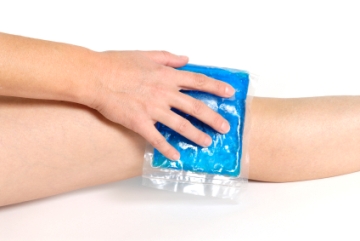If your child has ever twisted their ankle playing basketball, had their hand stepped on during a football game, or been kicked in the shin playing soccer, you probably already know about the swelling that occurs after a sports injury. Swelling is actually one of the ways the body protects an injured area against further damage in the immediate aftermath of an injury. The combination of restricted motion, pain, and generally ill feeling will likely take an athlete off the playing field, and, sometimes, on to a physical therapist's treatment table.

One question I am often asked by parents is whether their young athlete can return to sports if swelling is still present. There a number of factors a physical therapist will consider in providing an answer:
Extent of swelling
Certain areas of the bodies are prone to swelling, such as the ankle after spraining it or the hip after a serious fall. Upon starting physical therapy, a physical therapist will compare the injured to the uninjured side in order to get a general idea of the extent of swelling. This measurement will then be used to measure improvement and recovery from injury during the treatment process.
Variability and stability
It is common for the amount of swelling to vary over the course of a day. Swelling in the legs tends to be less in the morning, increasing as the day wears on, particularly if the injured athlete is sitting for long periods of time (such as in class). A joint that significantly swells should be taken as a sign that your child is likely not ready for increased activity, as it indicates a persistent inflammation process.
Sometimes, though, a joint may remain somewhat swollen even a few months after injury, but if the joint is stable, so that it is able to withstand the stress of complex athletic movements, such as sharp cutting and twisting, it may nevertheless be safe for the athlete to return to play.
Other effects of swelling
Swelling has a variety of effects on the body, most commonly a feeling of tightness and/or pain, and a restriction on mobility. Some of the more serious effects of swelling that a physical therapist will be watching out for are:
- Significant swelling around the knee joint, which will inhibit the quadriceps muscles, particularly the vastus medialis oblique, which helps to fully straighten the knee and track the patella (kneecap) correctly. Significantly, swelling will decrease the muscular stability of the knee joint and cause irritation from the patella tracking laterally (side to side).
- Severe swelling of the shin as a result of blunt force trauma: such swelling requires immediate medical attention to prevent a condition known as compartment syndrome, which can cause damage to nervous tissue running down the front of the leg.
- Lasting swelling that leaves a finger indentation after pressure is applied: Also known as pitting edema, such swelling is cause for concern, and if it persists for a long time, may indicate poor overall circulation. While it generally does not pose a serious threat in young athletes, it is something to keep an eye on.
What parents need to know
A swollen joint is generally more "bark" than "bite" when it comes to injury. It is a natural part of the healing process but still important to control. All that may be necessary is basic first aid, known by the acronym "PRICEM", which stands for:
- Protection(by removal from play)
- Rest
- Ice
- Compression
- Elevation; and'
- Medication (eg. anti-inflammatories)
Following these steps ensures that the swelling will not seriously impact or damage the underlying soft tissue, nerves, and bones. With respect to medication, talk with your child's pediatrician or primary care physician to make sure they are appropriate and necessary.
The most important point to remember is that swollen joints significantly impact athletic movement, such as running, jumping, cutting, sliding, etc. and that engaging in these activities increases the risk of further injury to the joint. Swelling can decrease muscle activation, impairing some of the protective forces around a joint. Any suspicious swollen joint or body part that is impairing sports performance should be evaluated by a doctor, physical therapist, or athletic trainer.
Posted January 14, 2012








